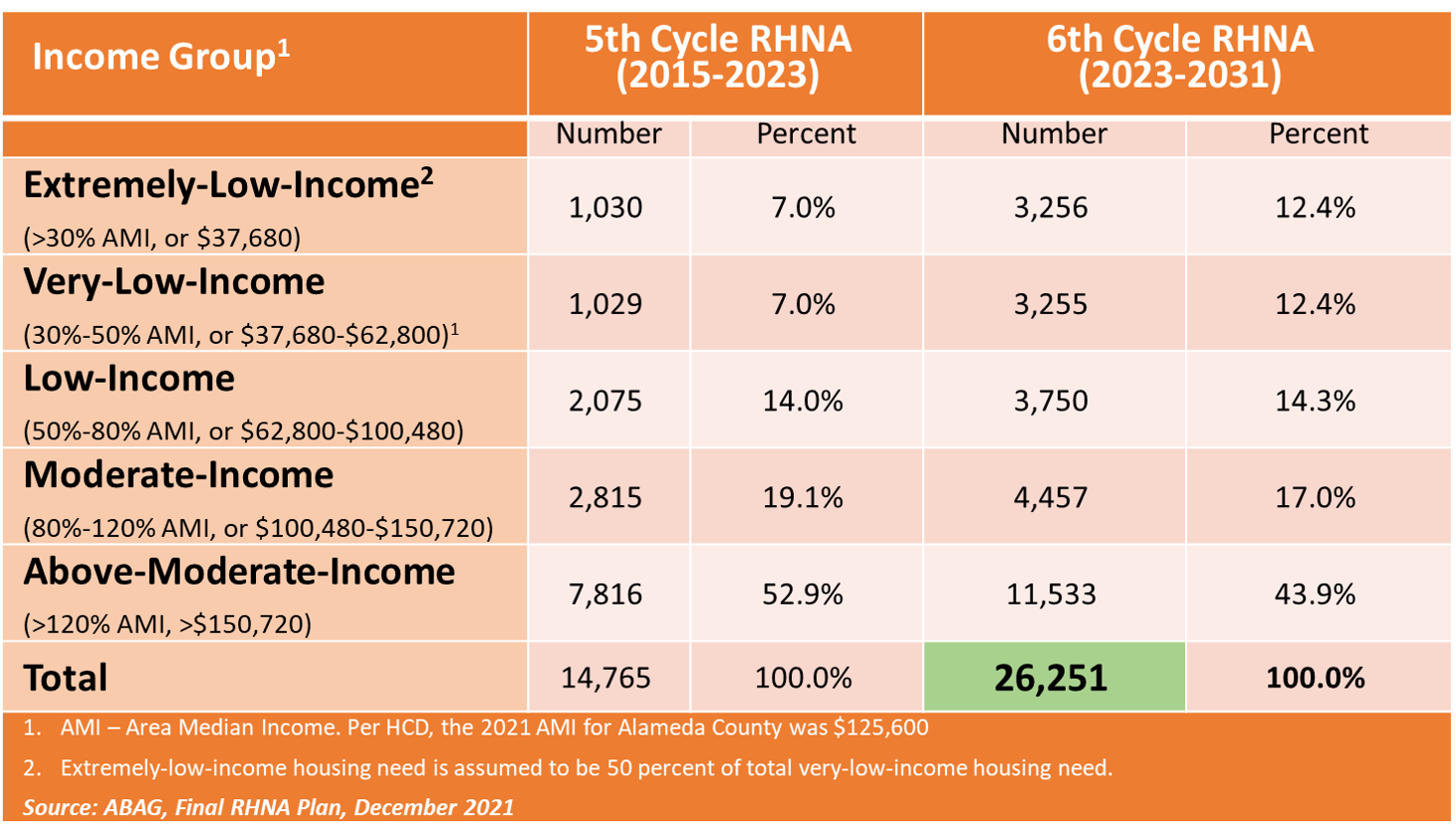The General Plan is composed of six required elements, of which the Housing Element is one of them. The other required elements are: 1) Land Use and Transportation Element (LUTE); 2) Open Space, Conservation, and Recreation (OSCAR); 3) Noise; 4) Safety; and 5) Environmental Justice. An overview of the framework for the General Plan can be found here.
- What is the relationship between the Housing Element and the General Plan Update?
- What is the purpose of the Housing Element and how does/will it affect affordable housing development in Oakland?
- What was the schedule for the 2023-2031 Housing Element?
- How often is the Housing Element updated?
- How is "affordable housing” defined?
- What is the Regional Housing Needs Allocation (RHNA)?
- What is Oakland’s 2023-2031 RHNA Allocation?
- Where can we access the previous Housing Element should we want to read it?
- How can I find additional information on the 2023-2031 Housing Element Update?
What is the relationship between the Housing Element and the General Plan Update?
What is the purpose of the Housing Element and how does/will it affect affordable housing development in Oakland?
The Housing Element is one of the required elements of the General Plan. It identifies policy direction to meet the housing needs of the City, both by preserving existing homes and by clarifying priorities for new construction. The plan includes an overview of housing policies and programs and identifies locations that can accommodate future housing.
What was the schedule for the 2023-2031 Housing Element?
The schedule of past meetings and events for the adopted 2023-2031 Housing Element can be found on our website at: https://www.oaklandca.gov/topics/oakland-general-plan-2045-housing-element.
How often is the Housing Element updated?
All cities in California are required to adopt a Housing Element as part of the General Plan to adequately plan for the existing and projected housing needs of all economic segments of the community. The Housing Element must be certified by the State and updated every eight years.
The California Department of Housing and Community Development (HCD) found Oakland's 2023-2031 Adopted Housing Element in full compliance with State Housing Element Law (Article 10.6 of the Gov. Code) on February 17, 2023.
How is "affordable housing” defined?
Each year, the California Department of Housing and Community Development (HCD) updates the state’s income limits based on changes the U.S. Department of Housing and Urban Development (HUD) makes to its Public Housing and Section 8 Income Limits. Income categories are based on area median income (AMI), which is the median family income for a geographical area, as estimated by HUD for the Section 8 program. Income limits are used to determine eligibility for many state and federal housing assistance programs. The state’s five income categories are:
- Acutely Low income: 0-15% of AMI;
- Extremely Low income: 15-30% of AMI;
- Very Low income: 30-50% of AMI;
- Lower income: 50-80% of AMI; the term may also be used to mean 0% to 80% of AMI; and
- Moderate income: 80-120% of AMI.
The 2021 state income limits took effect in December 2021. The image below shows the breakdown for Alameda County.
The state’s Regional Housing Needs Allocation (RHNA) determines the number of homes and the affordability of those homes that each local jurisdiction must plan for in its Housing Element. The total number of homes is divided across four income categories:
- Very Low income: 30-50% of AMI;
- Low income: 50-80% of AMI;
- Moderate income: 80-120% of AMI; and
- Above-Moderate income: 120% or more of AMI.

What is the Regional Housing Needs Allocation (RHNA)?
California state law recognizes that local governments play a vital role in developing affordable housing. In 1969, the state mandated that all California cities, towns and counties must plan for the housing needs of our residents—regardless of income.
This state mandate is called the Housing Element and Regional Housing Needs Allocation, or RHNA. The Regional Housing Need Allocation (RHNA) process is used to determine how many new homes, and the affordability of those homes, each local government must plan for in its Housing Element. This process is repeated every eight years, and this is the 6th cycle for the period from 2023 to 2031.
Working with the State Department of Finance, the CA Department of Housing and Community Development (HCD) assigns future housing and population growth projections in eight-year cycles to every Council of Government (COG) in the State. The COG for the 9-County Bay Area is the Association of Bay Area Governments (ABAG). ABAG, working with the Housing Methodology Committee (HMC), then distributes a share of the region's housing need to each city, town and county in the region. Each local government must then update the Housing Element of its general plan to show the locations where housing can be built and the policies and strategies necessary to meet the community's housing needs at all income levels. The RHNA number includes a distribution of units to be provided across four income categories – very low income, low income, moderate income and above moderate income.
For additional information, check out the following links:
What is Oakland’s 2023-2031 RHNA Allocation?

Where can we access the previous Housing Element should we want to read it?
The 2015-2023 Housing Element is available online: https://www.oaklandca.gov/resources/read-past-drafts-of-the-housing-element.
The City also releases Annual Progress Reports (APR) that document progress towards implementing policies adopted as part of the 2015-2023 Housing Element. They can be accessed at: https://www.oaklandca.gov/documents/housing-element-annual-progress-reports.
How can I find additional information on the 2023-2031 Housing Element Update?
All past events can be found on the main general plan website: https://www.oaklandca.gov/topics/general-plan-update and summaries of past events, including recordings from the Housing Element workshop, can be found here: https://www.oaklandca.gov/topics/meetings-and-events#past-events-and-meetings.
The 2023-2031 Housing Element website can be accessed here: https://www.oaklandca.gov/topics/oakland-general-plan-2045-housing-element.
Posted: March 22nd, 2022 10:20 AM
Last Updated: March 14th, 2023 10:41 AM
